Day Three of CIN (Christmas in November) 2010: Sensational Sushi Lesson with Lively Chef Brett Yasukawa!
I awoke the the second morning in the mountains to a beautiful blue sky and a ray of sun sneaking through the window dancing around the floor of the room. I could see I would miss the tour of the kitchen this morning. Tomorrow.
The brisk air was revitalizing! Coupled with the feathery clouds circling the mountain rearing its peak to the warm fingers of the sun, I found myself dancing my way to the lodge.
This breakfast was not a repeat of yesterday’s.
The variety and unexpected delights were somewhat overwhelming. The brass stands that the chaffing dishes rested in were stunning.
I was disconcerted by the cereals. Everything else was so wholesome and lovingly prepared.
Ah! A little oatmeal was my choice of morning nourishment today. If yesterday was any indication of what was ahead, every session would probably included eating something again. This would be plenty!
Me and some of my table mates.
Heading out, still early, to get that front row seat, I saw the fruit and bars again beside the door to pocket in case you may be hungry later in the day. That made me smile.
And it was tempting. The bars looked really good!
I was the only one in the room where Chef Brett Yasukawa would be presenting the sushi making session. I like being first and I was really looking forward to this session because the word was out, “This is is a great session and you must go!”
It was clear this was to be a hands on session. Wonderful! This is so necessary, particularly with sushi. I have definitely tried my hand at it before. That is why I am here!
I snooped around “politely”, eyeing all the curiosities in the front of the room.
Beavie was just posting for me when suddenly Chef Yasukawa was there! This day, many did come to the session early. I was glad I had secured my “eager beavie” front row seat.
Chef Brett Yasukawa, 40, started in the industry at age 15 as a dishwasher. By his 17th birthday, Brett secured a sushi apprenticeship in Palo Alto which he completed. Graduating from the California Culinary Academy in 2000, Brett was also leading the opening team of Chinois and Spago Las Vegas for Chef Wolfgang Puck. After mastering his craft as a Sushi Chef, Brett traveled through the United States working with the famous Nobu restaurants in Beverly Hills, New York and Nobu Las Vegas which was awarded One Michelin Star. Restaurant Yasu, Brett’s namesake, opened its doors in 2007 to San Jose. Taking on apprentices of his own. With the window of opportunity opening at the famous “˜Tonga Room’ at The Fairmont San Francisco also in 2007, Brett became the Executive Restaurant Chef. Brett is now taking time to explore his personal passions outside of the kitchen while still consulting for restaurants.
“œMy style of cuisine is derived by old school methods but translated into a new form of uniqueness. It is not “œfusion” food in any shape or form. I don’t force flavors together to create a theme. I learned traditional Japanese methods and express them through a 4th generation Japanese American’s eyes. It is simply how I cook.”
In the worlds of Chef Brett Yasukawa:
- Greetings, all! I am from CA and this is my first time in Canada
- As a Chef at the Fairmont in San Fran for a number of years; once you walk through the doors, you all become family. You are all part of the fairmont family here, and I want you tofFeel at home here, please…
- This is not a classroom; think of it as a fun dysfunctional sushi session and I am the captain! (Valerie: you needed to be there to see his wicked grin!)
- I am a Japanese trained sushi chef
I love sushi and have since one of my principals took me for lunch and had me try it. It is so delicate and pure. There is nothing like the texture or mouth feel of sushi.
- My sensei told me the most important thing about sushi is the rice
- It is so important to measure and take care of it
- I am going to demonstrate somethings and talk to you about the rice Upper right photo is the best brand of Japanese sushi rice)
- Then we will have a sushi pow-wow and you will all get up and roll your own. You don’t have to, but you will have the opportunity.
- The one thing I want to show you is from A to Z
- I will show you how to fix it and put it on a nice platter for a nice presentation so you can have great parties with sushi everywhere!
(Beavie is concerned: Sushi everywhere! Yikes! )
Making RICE in the worlds of Chef Brett Yasukawa:
- When making sushi, everyone can have great fish, but not great rice
- Treat every single grain of rice like it is your wife: my sensei told me that
- Handle it softly, massage it, make sure it’s wet and never hang it out to dry (Valerie: lots of giggles here, for sure!)
- As sushi is so simplistic, the elements have to be precise
- Costco carries Kokuho Rose rice which is “OK”
- Better rice is: Tamanishiki (photo above in the lower right corner of the 6 small photos); it is a short grain rice and a little more expensive. This is better for restaurants and TWICE as good for home cooks, so if you find it, buy it as the bag is big and you will have it for awhile (Valerie: Chef Brett actually sent me an e-mail after CIN telling me he was in Edmonton, and had found this rice over at T and T!)
- Most rice comes from the USA; Sacramento Valley is growing more rice for Japan than Japan does, now
- Rice pots and rice cookers are great and here are the recommended brands (you cannot break them!):
- Panasonic
- National
He passed around the two different kinds of rice you can use for sushi, and has clearly made his preference clear: the short grained Tamanishiki.
Making Rice Recipes as told by Chef Brett Yasukawa:
1.    Wash three cups of rice:
- measure each perfectly level into the cooker (room temperature water) and do what sensei said: wash and massage this rice 5-7 times FIRST and do it all at one time and do not leave out one grain
- strain out every single bit of water each time you wash it; this is a very important step to having good sushi rice
2.    Three cups of water:
- measured exactly
- wipe all grains of rice from the sides of the pan and submerge them in the water (or you might break your tooth on one of those hard little forgotten grains)
3.    Cook for 35 minutes, not 30 as in the recipe in the CIN book that has been provided to attendees
- soak for 10-15 minutes in the water to warm up the grains before you push on the start button
- do not play peek-a-boo once you have started the cooking process: no peeking or the steam and the heat will pop out
4.    Test your rice: (do a trial batch to get used to the batch or kind of rice you are using: there may still be moisture in the grain, etc.)
- Elevation and relative humidity also affect your rice; you will need more water to cook the rice than in Hawaii (only @ 1/8th of a cup more, for example)
- Take notes so you know what you did and what to do next time
There is no doubt about it: Chef Yasukawa takes his rice very seriously. I had NO idea that preparing the rice was so labour intensive and that cooking it was so precise.
5.    Sushi Vinegar: Make your own Amazu (all recipes follow at the end of this post):
- One part rice wine vinegar , sugar and salt (recipe is in the CIN book given to attendees and at the bottom of this post)
- Amazu will last forever in the back of your cupboard, so once you make it, you will have it
- OR, use it in things like: salsa, sandwiches (oil and vinegar); make a spicy mayo (Hellman’s, Amazu, and Saracha all mixed together: yum)
6.    Pour Amazu into the Hot Rice:
- The temperature of the rice must be hot as that is necessary for the amazu to absorb into the rice
- Use a rice paddle or a spatula to break up the rice (discard all sticky balls)
- Spread it out onto a sheet pan as you fluff it up (do not force sticky balls, discard them)
- In 5-10 minutes flip it over ; and in 5-10 more minutes flip it over again (still watch for sticky balls and discard them as they appear)
- DO NOT OVERMIX you rice
7.    Texture of Rice (is so important):
- A guy I was working with had me test his rice: “œHere, try this” …as I picked it up, it held its shape, but in my mouth it dissipated and I could taste the texture and flavours etc.: that is how it should be
- Not the time when he went : “œHere, try this”… and had a tight sticky ball that he could throw across the room and it would hold its shape and stick to the wall on the other side
How to eat sushi (an answer to a question from the crowd):
- turn the sushi over and dip the FISH in the sauce, not the rice
- enter it into your mouth the same way so the fish hits the palate first and the rice dissipates
- there are a lot of untrained sushi makers “out there” : they are just sushi rollers”¦. They do this: but you must have a light hand and a soft touch to ensure it holds its shape but will dissipate
- push the rice along the edges for your “œsuper glue”; never water as the nori will dissolve
- ichi togarshi – means one spice
- shichimi togarshi ““ means 7 spices
If you study the photos of Chef Yasukawa handling the rice, you can see how gentle he is with it. I had many more photos to study that these, and I was reminded just how carefully he worked with each roll: it was as though he was honouring the rice and the process of the food preparation. (Or, it could have been the influence of the Scotch at the bar the night before as he had quipped about that!)
Later, he explained that this kind of roll is much more difficult to make than an inside out roll as you cannot fit as much into this roll.
He was careful to point out how important it is to cut each piece with a clean cut using a very sharp knife and so that all are exactly the same height when displayed.
The spicy mayo went onto the plate and then he plated his rolls. What is in the bowl? Crab!
He topped each roll with a generous dollop of crab and a bundle of micro-greens. Stellar. And really delicious! The sauces and the sprinkles to actually add a sparkle to the flavour profile of each toll.
Now, it is our turn. He had volunteers join him at both sides of the table. What to do. Take notes or get my hands in the food. I started to take notes, but couldn’t stand it. I will definitely be getting my hands in the food second round.
- buy good nori: it is either wrapped in blue or silver (photo below )
- check the packaging to ensure the little silk pack inside it is dry, not wet (the little pouch the comes in food to keep it fresh); it should feel like little mini-marbles, not like one big lump (below, right)
Rolling Sushi as told by Chef Brett Yasukawa:
1.    Nori: place the shiny and smooth side on the cutting board; rough side up
2.    Loosen your rice (fluff it up): grab it with your finger tips (snowball size); see pictures below
3.    Place the rice across the top of the nori, then take it from the top and move it down: do not press it down; do not touch it too much
4.    Hands in and out of the water: only use your finger tips
5.    Bring the rice down across the nori: don’t press down, press across
6.    Turn the nori over with the rice side facing the table
7.  Place your filling on the nori
8.    (You must work on a moist cutting board, but not a wet cutting board) This is the most important part: roll it over gently, don’t push, and just tuck it under very carefully to ensure there is no space left inside.
Watch the delicate touch.
As Chef Yasukawa was helping others, I see there is a set up for us to enjoy the fruits of our labours already. Yum.
9.    Take the albacore and put one in the middle and one on each side on the diagonal of your roll, leaving a space in between and going over the edges
10. Take a slice of avocado and again and place the thin slice in between the albacore
11. Lay plastic wrap over the roll about 1/4of the way down
12. Throw rolling mat on top; use your thumb at the back of the roll and the mat (closest to you) and apply just a little pressure toward the roll; Then, with your index fingers on top, and the others around the roll, using a very light touch, but enough to shape the roll. Remove the mat.
Watch this series of movements as Chef Yasukawa takes us through the shaping of the roll using the mat.
Cutting Sushi
- Leave the plastic wrap on the roll to cut it. Also, use the back part of your knife as it the least used and you need a very sharp knife to do this properly.
- Use the back part of the knife to cut as that is usually the sharpest, leaving the wrap on, at a 45 degree angle, gently slice it down : six slices (you want avacado and fish on the top of each)
- Reshape gently with the mat after slicing
- Place and add sauce and seeds
He has cut each piece to include both the albacore and the avocado on each.
And a swirl of spicy mayo, some black sesame seeds and some tiny red roe: stunning!
My turn!
I mean: our turn! Wash the board and my hands… prepare my snowball of rice.
Place it across the top of the rough side of the nori (smooth side down) and gently move the rice down across the nori: to not pull it or press it.
The Inspector approves.
Turn it over and place fillings on top: cream cheese, turkey and cucumber. I was surprised by the choice of cheese. I thought a cardinal rule was to never serve cheese and fish together. I asked Chef about this and he shrugged and said that he had just thought up this combination. Essentially: if it tastes good, why not? It was delicious.
Turn to tuck in leaving no space inside. I found it easy to do this, but could see I didn’t have enough rice on the outside. He assured me it was fine.
This time, lovely salmon for the top.
Plastic wrap over the salmon.
Gently use your thumb up against the mat to move it into place.
With both hands, forefingers outstretched, others wrapped around the mat, gently shape the roll.
I got tail flapping and eager applause from my Beavie!
Voilà ! (I would say it in Japanese, but I don’t know how!)
We did not slice our own sushi this day. Something else to look forward to!
Do you see the outstretched arms and sense the terror?
Neither of us could believe how gorgeous this roll was.
This one had Maple Terriaki Glaze and Cranberry Jus on top of each (the jus was made with cranberries, orange juice and sugar) for the Salmon Sushi and Hijiki (black seaweed) for garnish.
Notes about Sushi:
- Can be made up to (but no more than) 5 hours ahead
- use regular Kikoman soya
- Chef doesn’t even eat ginger with sushi to clean his palate
I cannot believe he is actually 40! Chef Yasukawa was great fun. His lively attitude, hands on approach and warm family atmosphere made this class a huge hit for me.
I popped the other one in my mouth on the way to my seat!
Holiday Surf and Turf Roll Recipe:
A smoked slamon and turkey roll with Maple Teriyaki Cranberry Jus
Ingredients inside the roll:
- smoked turkey
- cream cheese
- avocado
- kaiware spice sprouts (we didn’t use these and I didn’t ask about them)
Ingredients outside the roll:
- smoked salmon
- black and white sesame seeds
- kaiware spice sprouts (you will see that we didn’t use these)
Ingredients for the Maple Teriyaki Sauce:
- 3 parts teriyaki sauce and 1 part maple syrup (adjust ratio depending upon the flavours of the two ingredients you select)
Ingredients for the Cranberry Jus:
- puree whole cranberries, strain with fine strainer
- add sugar to taste and a dash or orange juice is it is too thick
Making Japanese Rice Recipe:
Ingredients:
- 3 cups Japanese short grain rice
- 3 cups water
- 1 rice cooker
- 1 strainer
Instructions:
- Wash rice with room temperature water, running your fingers through it to lightly scrub the grains; drain thoroughly and repeat a minimum of three times
- Use the strainer to discard all excess water from the washed rice
- Add three cups of water, ensuring all rice kernels are immersed in the water, and not sticking to the sides of the pot
- Cook: do not lift the cover for 35 minutes; this will enable the heat and moisture to develop perfect rice
- See continuation: Making sushi rice, below, if necessary
Notes about Rice:
- Slightly more water will be required at higher elevations, or if the rice is from an older harvest (maximum to 1/4 cup more)
- Take notes when you cook your rice as it may be from an older harvest when you purchase it and you will not know until you cook it and then you will have to adjust the water amount for the next time
- Recommend that you use a Japanese rice cooker: panasonic or national
- Tamanishiki short grain rice is the best brand to use
Amazu Recipe:
Ingredients:
- 21/2 cups Japanese rice vinegar
- 1 1/2 cups sugar
- 3/4 cup kosher salt
Instructions:
- Combine ingredients together and store
Making Sushi Rice Recipe:
Ingredients:
- 3 cups uncooked Japanese rice
- 6/10 cups of Amazu
Instructions:
- After the Japanese rice has been cooking for 35 minutes, take the cover off and evening pour the Amazu over the rice
- Using a spatula, empty the rice onto a sheet pan lightly mixing the Amazu into the rice
- Break up and remove any rice balls
- Do not comer this
- Cool for 5 minutes on one side
- Turn over and cool for 3 minutes on the other side
- Reserve in a bowl with a damp towel or a few layers of damp paper towel covering the top
Notes about Sushi Rice:
- Adding the Amazu after the rice cools will result in the vinegar not absolrbing into the rice kernels
- Makig rice over the recommended amount in the rice cooker will result in cooking times over 35 minutes
- Over mixing the rice will result in mashed, broken grains that is too sticky to handle
“Christmas in November” from Yasu on Vimeo.
Make sure you check out the link above. Chef Yasukawa made it of his Christmas in November experience, and it rocks!
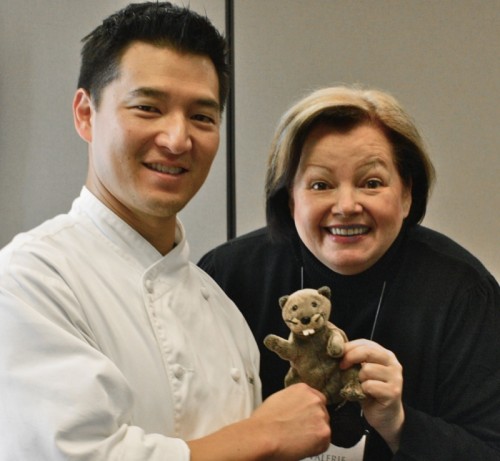




















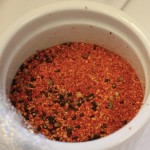
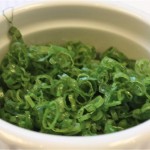






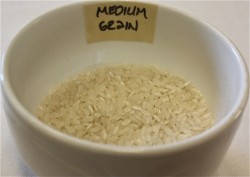








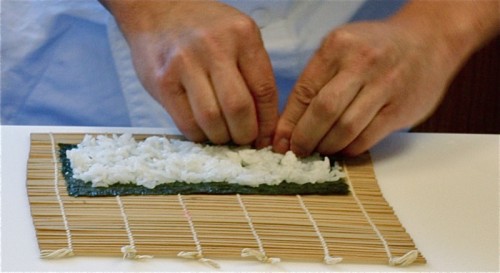







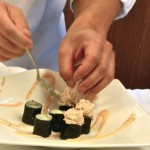



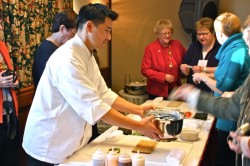



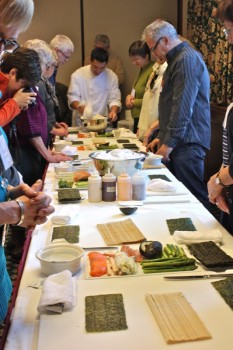
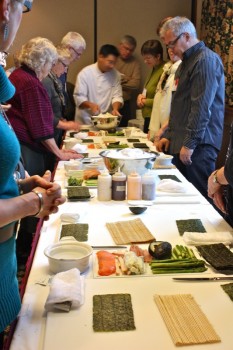


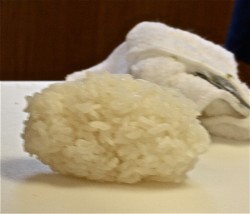





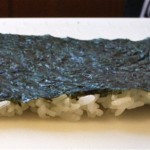












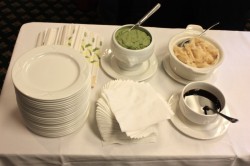






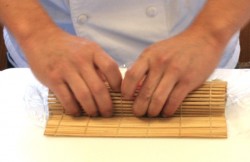








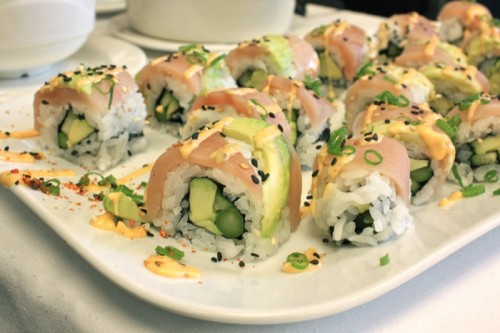

















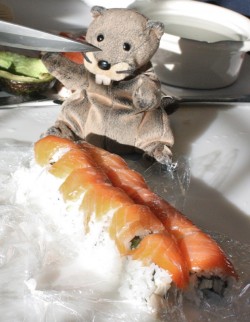

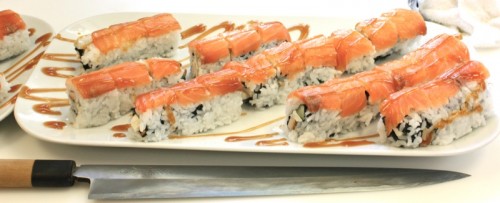







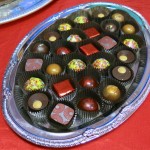





What a great sounding class. THe sushi looks stunning. I really know very little about sushi, but I think its one of the most beautifully prepared foods there is.
And I love that chef, you know why? He posed with Beavie :D. For that he gets a gold star in my book.
*kisses* HH
Hey Valerie,
I cannot believe that Chef Brett Yasukawa is 40 either. He looks so young! What a fun class to participate in. I know I’d love to experience a sushi making class taught by a chef. My mom makes very simple sushi at home for a snack sometimes. Having a sharp knife is a definite must when cutting sushi. I loved reading the little tips that Chef Yasukawa had. I’ll remember to cut with the back of the knife next time. I’m not sure which rice my mom uses, but I’ll suggest this one to her next time. I’m really starting to like how well stocked T & T is. I find them a bit pricier than the Chinatown Asian supermarkets, but I don’t mind paying a bit more if it means I can buy everything at one store. Looks like you and Beavie both had fun. Your rolls turned out beautifully!
I remember back in the 80’s going to the Cookbook Store in Calgary for a lesson in sushi making. I still have the equipment but my daughter is the sushi maker in the family. We also don’t usually make more than California rolls so obviously need to branch out. This is a great pictoral Valerie.
Lucky! How I would love to learn to make sushi from an expert.
These inside out sushi look GREAT! So is the Chef. ;-))
Valerine, this was a wonderful post. In regard to your request. I’ve looked into feedburner and unless I’m reading it incorrectly the service is no longer free. I haven’t given up trying to find a way to notify you. Please bear with me. Blessings…Mary
Sushi looks good. Those fruit and nut bars look pretty good as well. Do you have a good recipe for those? Also, the little Canadian Beaver is priceless–you should consider having a giveaway for one of those cuties in the near future!
I’d be snooping and dancing my way around this lodge too if I knew that I was going to be spoiled with the likings of this incredible chef.
I absolutely adore sushi, particularly ‘makis’.
After being here on your post…I just got a craving that will haunt me until I meet my client for Japanese food tomorrow ;o)
Valerie…you certainly went all out showcasing this wonderful class…thank you.
Ciao for now,
Claudia
I’m so happy that Brett is doing something he loves. I once worked alongside Brett and to this day when I handle a knife, I think of him and all he taught me. He’s an amazing man, and anyone that meets him is truly blessed.